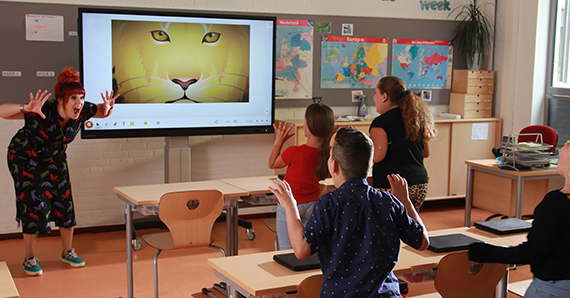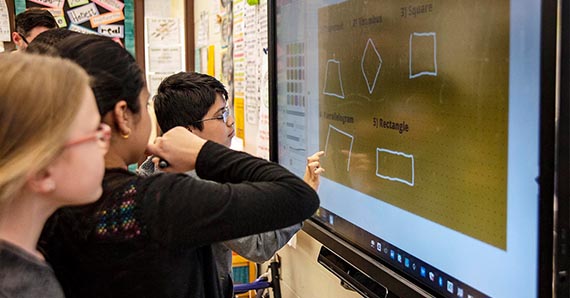This is a concern for many education decision-makers since they understand that today’s students need essential technological skills to compete in the future job market.
Hundreds of schools have invested in educational technology such as a 1:1 device for each student, interactive whiteboards and/or throw projectors for classrooms, and learning management systems to track student progress and provide pertinent information regarding instructional needs. But moving beyond the basics can be seen as too much of a time and monetary investment. Is this truly the case?
Many districts and schools are trying to close the digital divide by investing in technology solutions that: 1) offer more opportunities to enhance teaching and learning so that all are engaged; 2) help teachers ensure that instructional time is used more efficiently; and 3) provide students of all abilities access to the material that meets their learning needs. In the past year, schools took note of how educational technology can make a positive impact on how much and how well a student receives instruction.
One such educational technology tool is the interactive display (also known as an interactive flat panel display, interactive panel, interactive touchscreen, or smart board). An interactive display can be thought of as a ‘huge tablet’ that provides teachers and students dynamic opportunities to access instruction in ways that they’re already familiar with - if users can tap, drag, scroll, and swipe then they can use an interactive display! In a previous article, the top features of an interactive display were discussed. In this article, let’s focus on why an investment in a display is worthwhile.
Top 10 Benefits of Using an Interactive Display
1. Increased engagement & active learning - Even the most reticent learner will appreciate the bright, clear images on the screen, as well as the interactivity possible during activities and lessons presented. A poster of the rainforest is starkly different from viewing a video simulating walking through the rainforest, including the ambient sounds which will make this type of learning experience unique. There is a plethora of resources available for increased interactivity that will engage students and motivate them to be more involved in lessons.
2. More opportunities to collaborate – At times, it can be a struggle to have students discuss and collaborate on activities and tasks. But because the look and feel of the interactive display is like their personal devices, the struggle is minimised. Some interactive displays have multi-touch capabilities so more than one student can come up and add annotations, highlight, or move content as they see fit. Quite a few displays also have screen mirroring software, so students learning from home can participate in class discussions. But more on that later.
3. Innovative software and learning apps - To attract more schools, many companies are making sure that their interactive displays come equipped with classroom software and learning apps. Exceptional classroom software allows teachers to create interactive lessons that include multiple question types, docs, images, videos, slide presentations, and more in a matter of minutes. To reinforce lessons, displays can also include learning apps many of which are aligned with key learning objectives. Some apps include dual language support so that students can learn French, German, Spanish, and other languages.
4. Pose questions to gauge understanding - Classroom software that comes inbuilt on many interactive displays usually includes tools so teachers can view student responses to questions created for the lesson. Teachers can measure student understanding while presenting, and address misunderstandings right away rather than wait after grading a stack of paper tests. Some software and web-based platforms also allow for posing questions on the fly, which is a great way to get a sense of student interest and engagement in the topic.
5. Ability to import 3rd party interactive lessons - Because interactive whiteboards were the popular device for many years in tech forward classrooms, teachers have created and used activities and lessons that have proven very successful for them. They don’t want to waste the time invested in these treasured lessons. That being the case, state-of-the-art interactive displays have platforms that can import 3rd party interactive whiteboard lessons.
6. Screen mirroring for hybrid learning – State-of-the-art interactive displays have screen mirroring software which enables teachers to cast images on the display to student devices. Students can annotate on the images, which can be seen by anyone viewing the display. This is especially useful for hybrid learning environments when some students are learning from home. These students can participate in class discussions and collaborate on tasks using their web-enabled devices.
7. Accessibility for students with disabilities – Interactive displays have also been proven to help students with different disabilities participate actively in lessons. For example, students who have difficulty gripping writing tools such as a pencil or stylus, can use their fingers or palm to annotate on an interactive display. Displays mounted on carts help students who aren’t able to walk to or stand at the board. For an outstanding example of ways special education teachers have used interactive displays, read Interactive Learning for Students with Special Needs.
8. Incorporate STEM learning - It can be challenging to incorporate STEM activities and lessons that can bring the topics to life. With interactive displays, students can plan and facilitate experiments, share findings and results, and invite collaboration especially if the display comes with screen mirroring software. Science classes that have incorporated interactive displays rave about being able to invite experts for interviews via video conferencing, helping students envision a future with STEM playing a part.
9. Saves time – Interactive displays are a complete, out-of-the-box solution and don’t require excessive cables, hard wiring, or bulb maintenance. Teachers can save precious instructional time by not having to deal with making sure images are clear and focused, or connecting their PC to the display. Turn on the interactive display and start working.
10. Sync with cloud drives - Being able to work from anywhere at any time, then save content to the cloud has helped teachers create, collaborate, and share even when not on the worksite. Cutting-edge interactive displays feature the ability to sync with cloud drives such as Google Drive and Microsoft OneDrive so teachers can upload and share activities, administrators can share annotated meeting notes, and students can access assigned lessons or reference documents. To read how one school took advantage of this feature, read A Primary School Shares Their Success Story Using the Clevertouch Solution.

